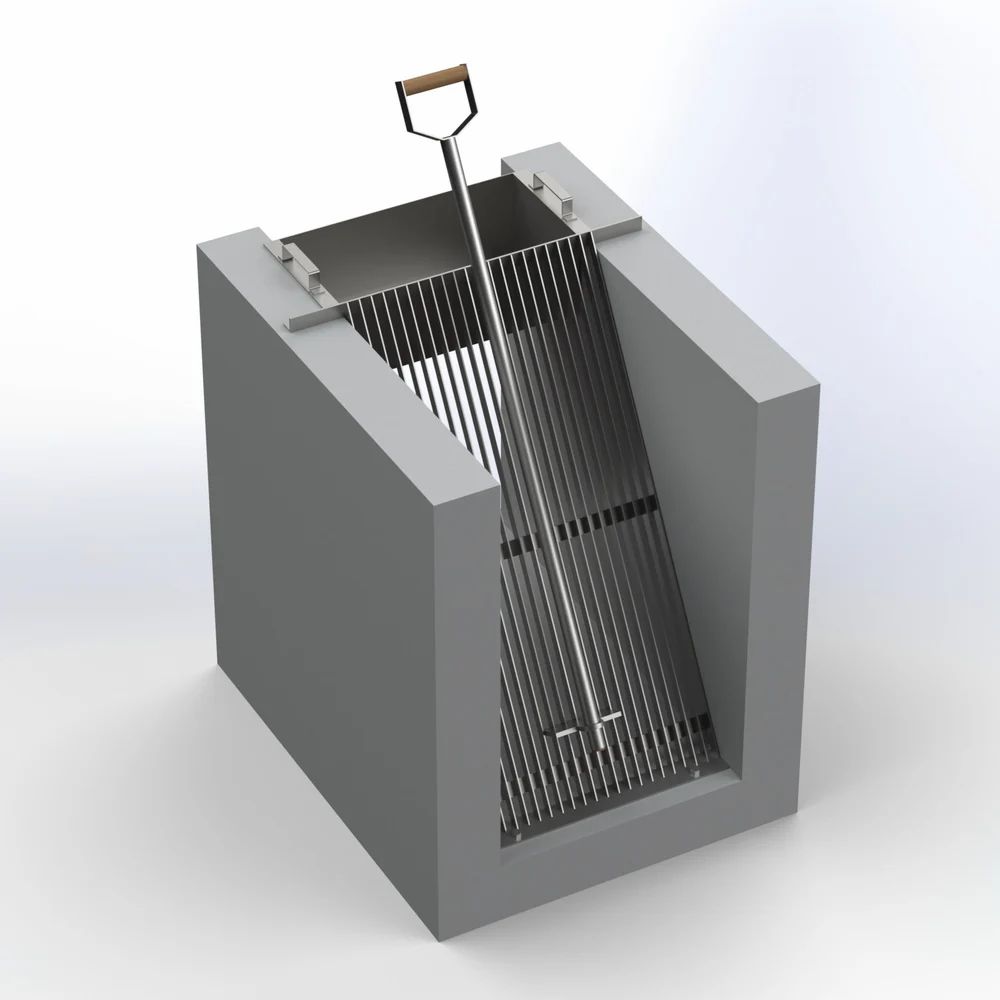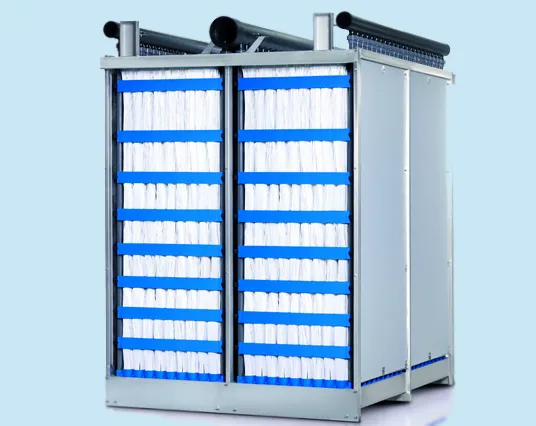Products

Motorized and Manual Sluice Gates
Sluice gates are utilized to control the flow into and out of channels and are equipped with seals to prevent leakage. They are available in different sizes to meet specific needs and can be made from SS304, SS316, aluminum, or mild steel. Operating systems include manual, electric, pneumatic, or hydraulic options.

Mechanical & Manual Screens
Bar screens are engineered for uninterrupted operation, utilizing parallel raking beams to freely clear the vertical screen grid. Micro-raked bar screens effectively eliminate suspended and floating coarse debris like weeds, reeds, and rags from surface water. They find primary applications in:
- Pumping stations
- Sewage treatment plants
- Cooling water inlets
These screens are constructed from robust materials such as suitable steels. Vertical screens span across the channel, with a dead plate fixed at the top of the bars where debris is discharged.

Fiber Disc Filter
Wastewater enters the central drum through the filter segments initially while the filter drum remains stationary. Suspended solids accumulate on the outer surface of the filtration disc segments, which are covered with fiber media cloth. As the cloth becomes clogged with solids, the water level on the tank side rises, activating water level probes. This action starts the rotation of the filter disc drum and simultaneously activates the backwash system. High suction pressure removes impurities, directing them to the sludge management system. Subsequently, the tank’s water level decreases, restoring the flow rate to its optimal level, automatically switching off the suction pump. This cyclic process ensures continuous, uninterrupted filtration.

Sludge Dewatering Machine
The ‘Micro’ Sludge Dewatering Machine is distinguished by its innovative design, offering efficient dewatering with minimal energy consumption and yielding high-solid sludge. Operating quietly and with minimal vibration, it is well-suited for industrial applications. User-friendly and easy to maintain, this machine integrates thickening and pressing into a single cylinder, eliminating the need for a separate thickener. It can handle low-concentration slurries directly from sources like sludge sumps, clarifiers, and oxidation ditches, producing dewatered sludge containing up to 22% solids.

Sludge Dryer
The Micro Sludge Dryer is purpose-built to effectively dry different types of sludge paste, encompassing biological and chemical varieties. These machines excel in efficiency, employing mechanical agitation and indirect heating through steam or thermic fluid. They are equipped with two counter-rotating paddle shafts fitted with intermeshing wedge-type paddles, ensuring thorough mixing and self-cleaning of heat transfer surfaces. This design enhances heat transfer efficiency while minimizing the equipment’s footprint.

Grit Mechanism
Grit removal comprises two essential components: the grit collection mechanism and the grit washing mechanism, each functioning independently but interconnected hydraulically.
The detritor operates as a continuous flow tank where grit settles under gravity while water exits through an outlet weir located opposite. A scraper mechanism moves settled grit towards openings on the classifier sidewall at the tank’s bottom.
The collection chamber operates on a velocity principle, allowing only grit to settle while organic matter overflows. A classifier mechanism, driven by a gear motor, employs a reciprocating rake or screw to thoroughly wash the collected grit. Cleaned grit is discharged from the classifier top via a chute for disposal. The Organic Return Pump / Mixer recirculates washed organic liquid from the classifier back to the Detritor collection chamber.

Clarifier / Clariflocculator / Thickener
Clarification is a fundamental and extensively utilized process in wastewater treatment, essential for effectively treating wastewater. Mechanical clarifiers within the activated sludge process serve a dual role. Firstly, they ensure the production of clarified effluent, and secondly, they provide a concentrated source of return sludge to maintain process stability, removing sediment, turbidity, and floating materials from wastewater.
Proper area and depth are critical to allow settling and compaction of the mixed liquor suspended solids (MLSS) from the aeration tank without carrying solids over into the clarified effluent. MICRO offers clarifiers in sizes up to 54 meters in diameter for peripheral drive systems and up to 30 meters for central drive systems, optionally with or without scum collectors. Materials of construction include SS 304, SS 316, and carbon steel.

Agitators and Flash Mixers
Micro Agitators are designed to provide effective agitation for treating process liquids, water, or wastewater in tanks of circular or square shapes. They are offered in sizes ranging from 1 to 25 HP, making them suitable for tasks such as chemical mixing, blending coagulants, neutralization, and general-purpose mixing applications.
These agitators excel in flocculation processes, offering exceptional circulation capacities of up to 25 times the feed rate. This capability ensures thorough mixing and efficient treatment of liquids in various industrial and environmental settings.

Pressure Sand Filters / Activated Carbon Filters
Pressure Sand Filters are widely recognized for their effectiveness in removing turbidity from water. They feature multiple layers of sand with varying sizes and specific gravities. These filters are specifically engineered to eliminate turbidity and suspended particles from feed water while maintaining minimal pressure drop.
Available in both horizontal and vertical constructions, Pressure Sand Filters are crafted from materials like carbon steel or stainless steel. They come equipped with face piping and associated valves, ensuring robust performance and ease of operation in various water treatment applications.

Skimmers
An API oil separator is designed to effectively remove free-floating oil from wastewater produced by establishments such as restaurants, laundries, refineries, and auto service centers. These separators operate by allowing the waste water to settle in a quiescent (calm) state, facilitating the separation of oil based on gravity.
As oil is lighter than water, it naturally floats on the wastewater’s surface. An endless chain-type scraper in a launder is used to collect the floating oil. To ensure efficient oil collection, a level controller is installed to maintain the correct oil level, making it easier to gather and manage the separated oil. This method leverages gravity separation theory to effectively separate and manage free-floating oil from wastewater streams.

Decanters - SBR Systems
Decanters play a crucial role in Sequencing Batch Reactor (SBR) systems by separating treated effluent from sludge at the conclusion of each treatment cycle. In the SBR process, wastewater undergoes treatment in distinct batches, progressing through phases that include filling the reactor, reacting with the wastewater, settling, decanting, and finally resting.
During the decant phase, decanters are utilized to extract the clear, treated supernatant from the reactor. This process effectively separates the clarified effluent from the settled sludge, ensuring that only the clean water is discharged while the sludge remains within the reactor for further processing or disposal.

Mechanical Vapour Recompressor (MVR)
Mechanical Vapor Recompressor (MVR) is an industrial device designed to compress low-pressure vapor, usually water vapor, to a higher pressure and temperature. By doing so, it recovers the latent heat contained in the vapor. This recovered heat is valuable and can be utilized to evaporate additional incoming feed material in processes like evaporators or distillation units.
In practical terms, an MVR system helps in energy efficiency by reusing the heat energy from the vapor, thereby reducing the overall energy consumption of the process. This makes MVR systems particularly advantageous in industries where vapor compression and heat recovery are critical for efficient operations.

PURON® MBR and PULSION® MBR Modules
This patented module incorporates reinforced PVDF hollow fibers secured only at the bottom, significantly reducing the risk of clogging from hair, fibrous materials, and sludge solids. Solids and particulates, including bacteria, are retained on the outer surface, while permeate passes through the membrane into the interior of the fibers. A centrally positioned aeration nozzle effectively cleans the entire length of the fiber bundle, thereby minimizing power consumption.

ASPIDA™ Module
The ASPIDA membrane is crafted using proprietary technology, yielding a robust PVDF membrane that is chemically resistant and highly permeable. Unlike traditional membranes, the ASPIDA membrane is isotropic, meaning it exhibits consistent mechanical properties in all directions across its structure. This uniformity enhances its integrity, durability, and robustness, reducing the likelihood of fiber breakage and enhancing its chemical tolerance significantly.

